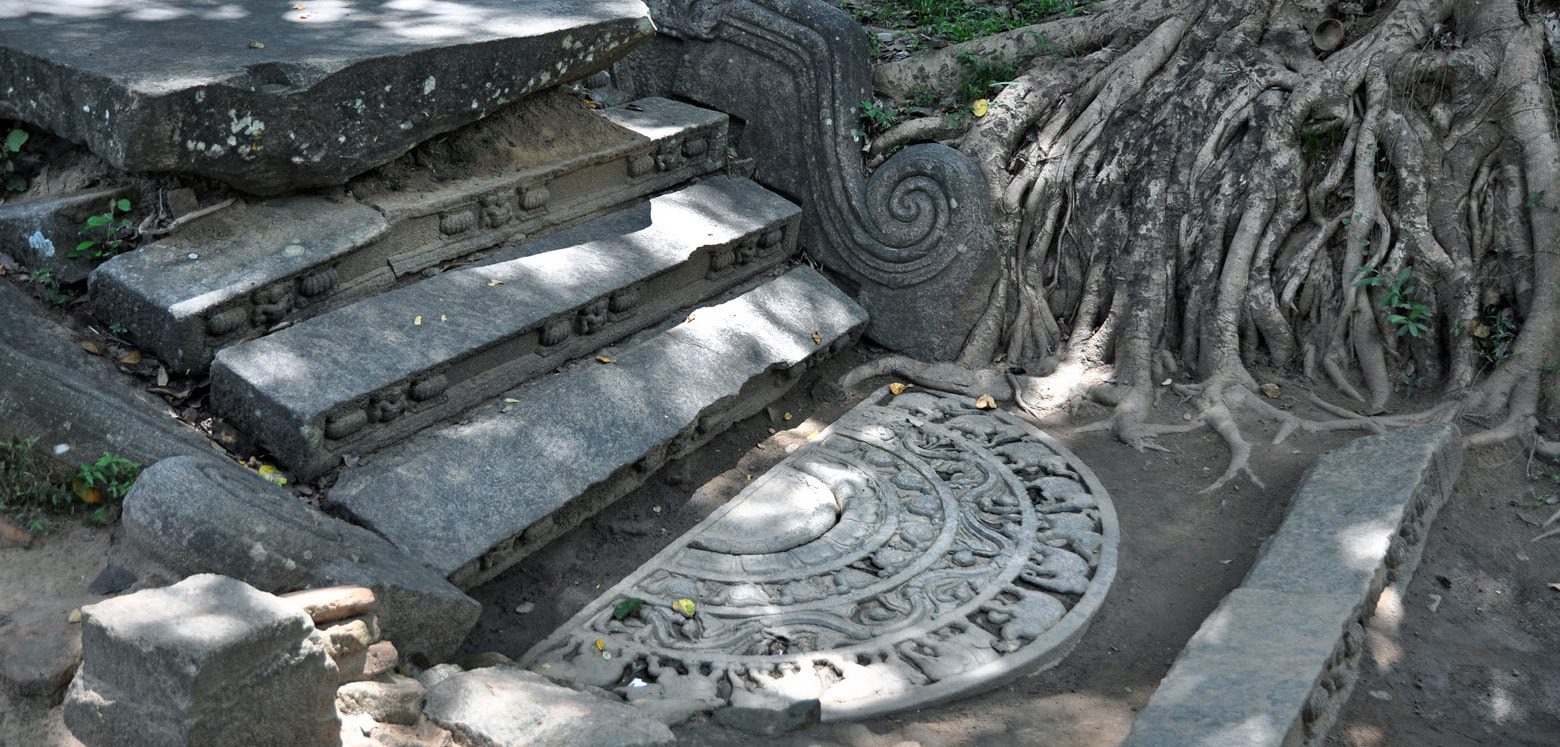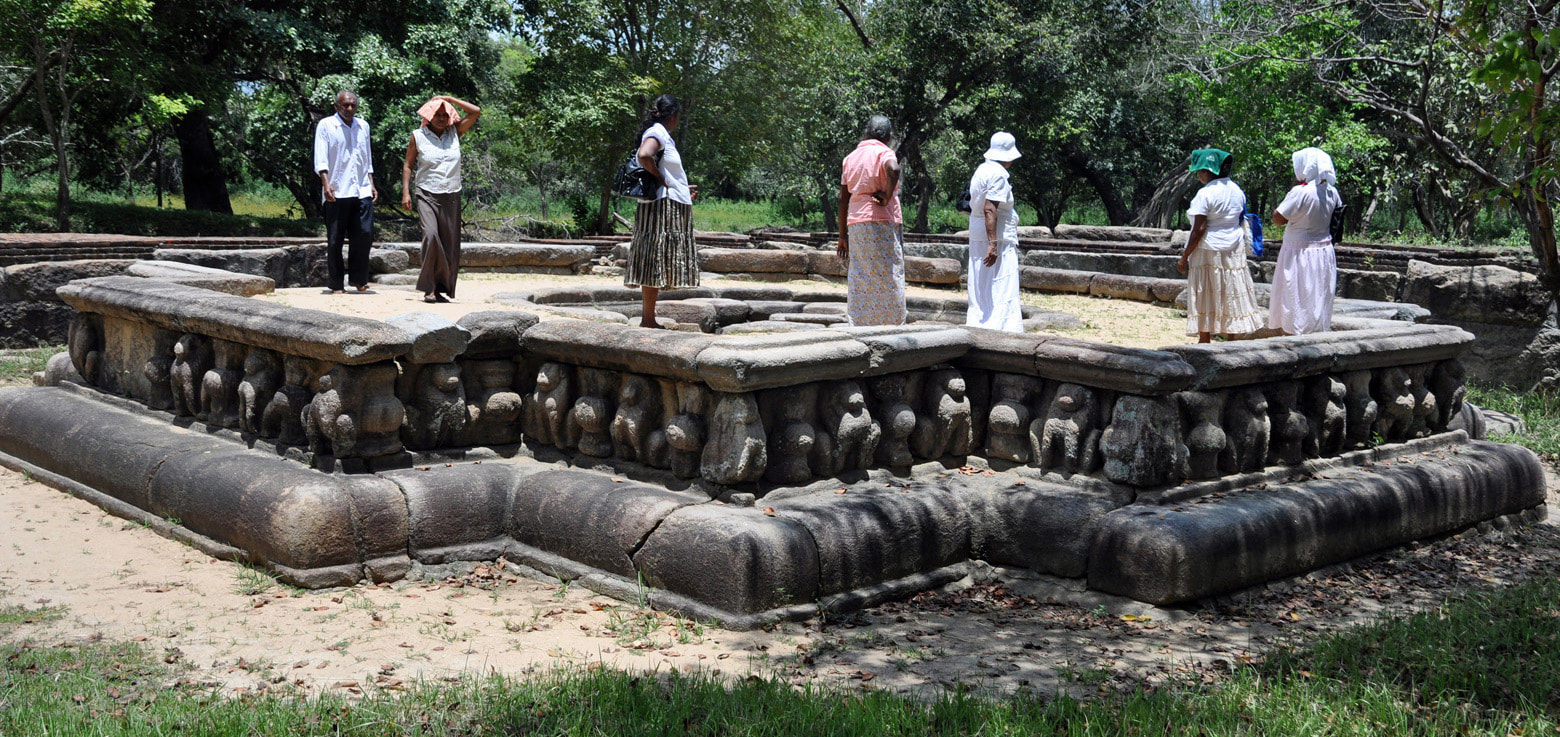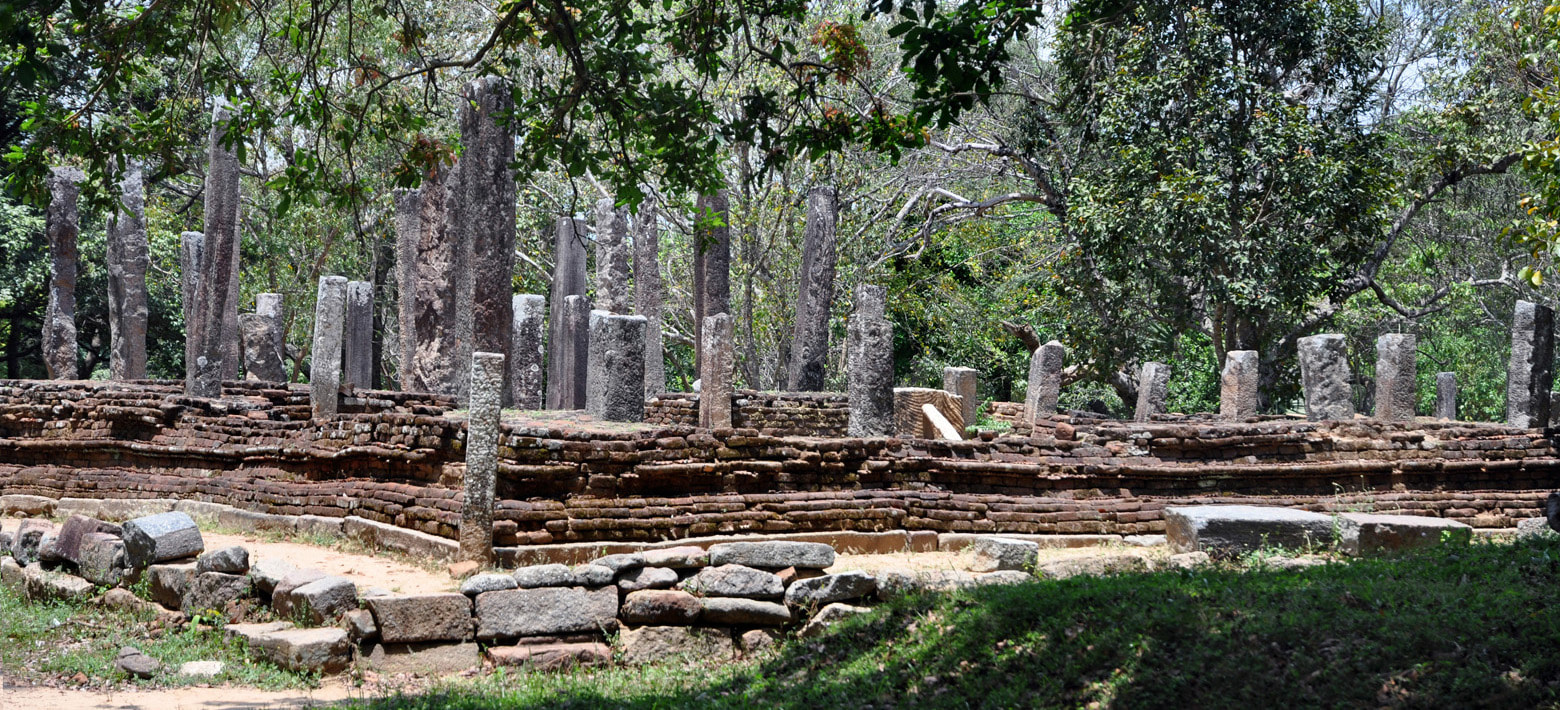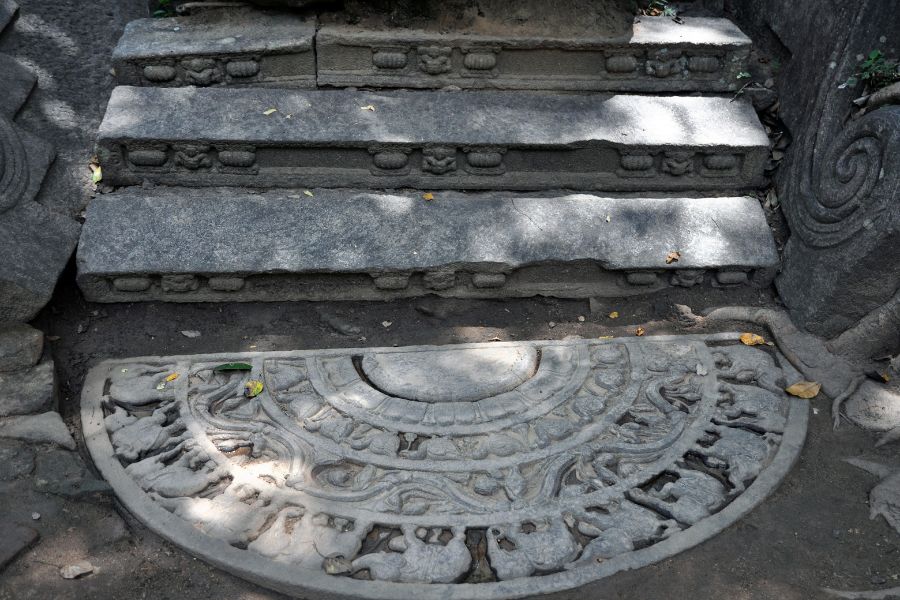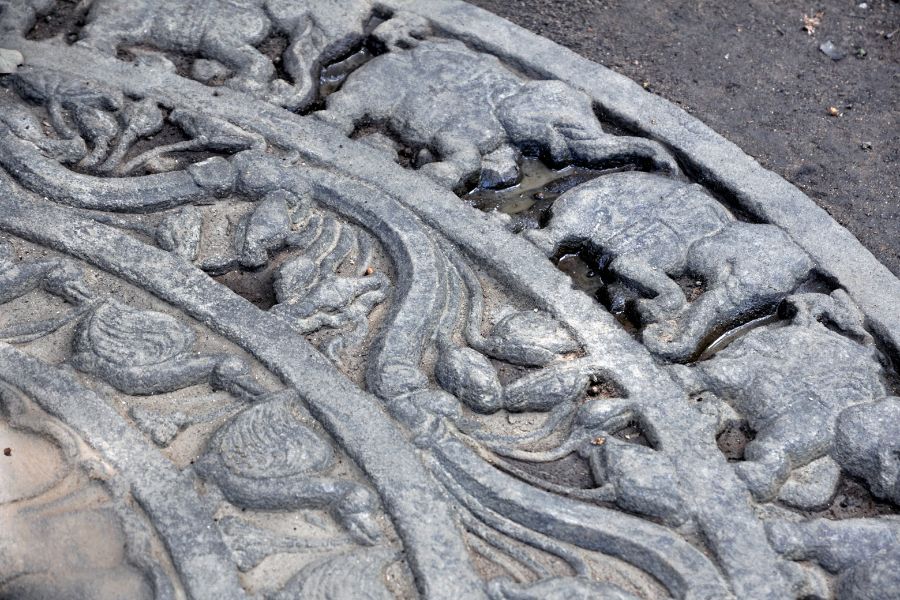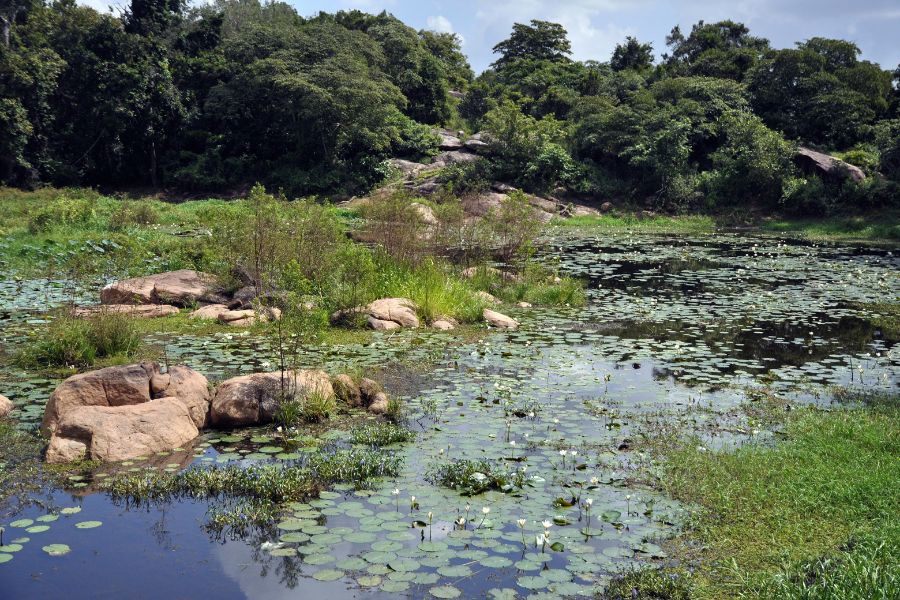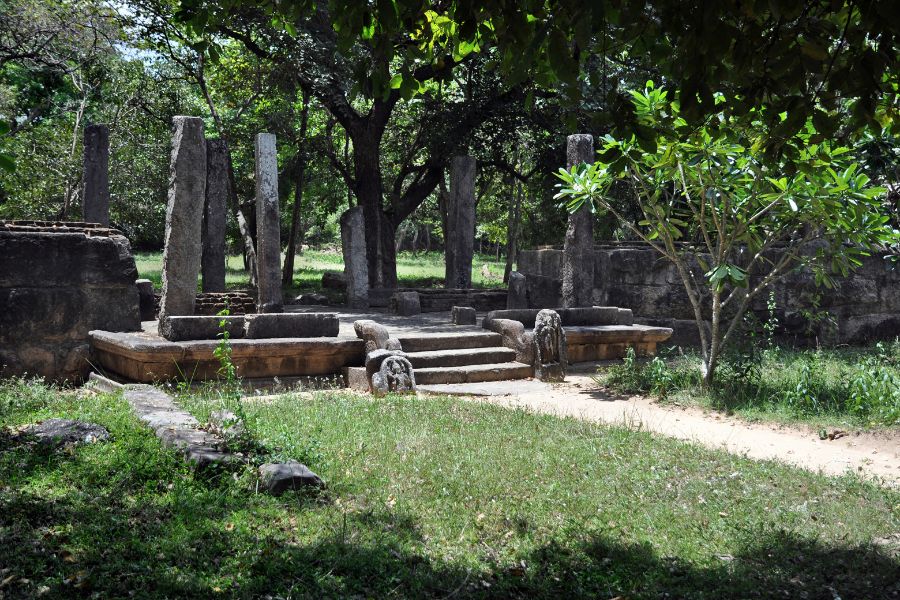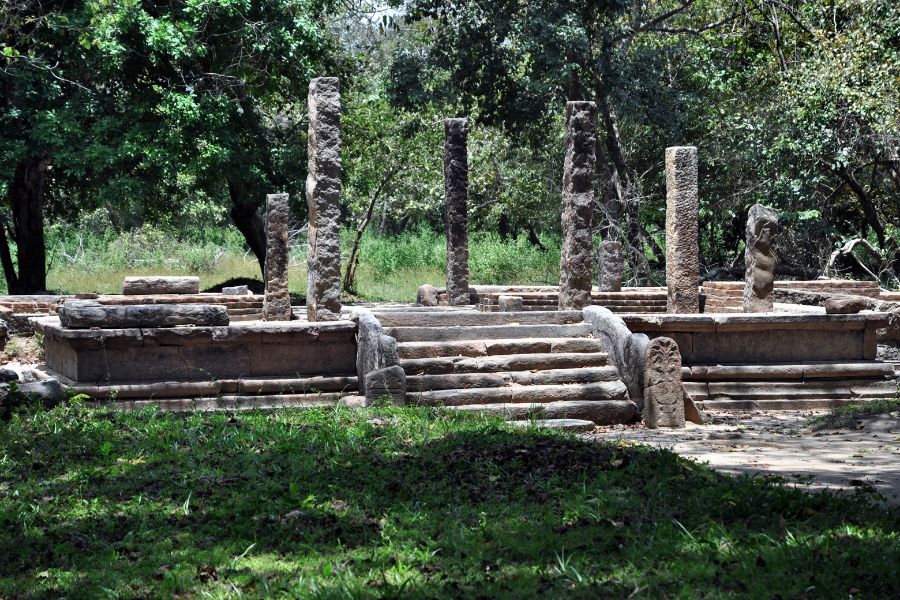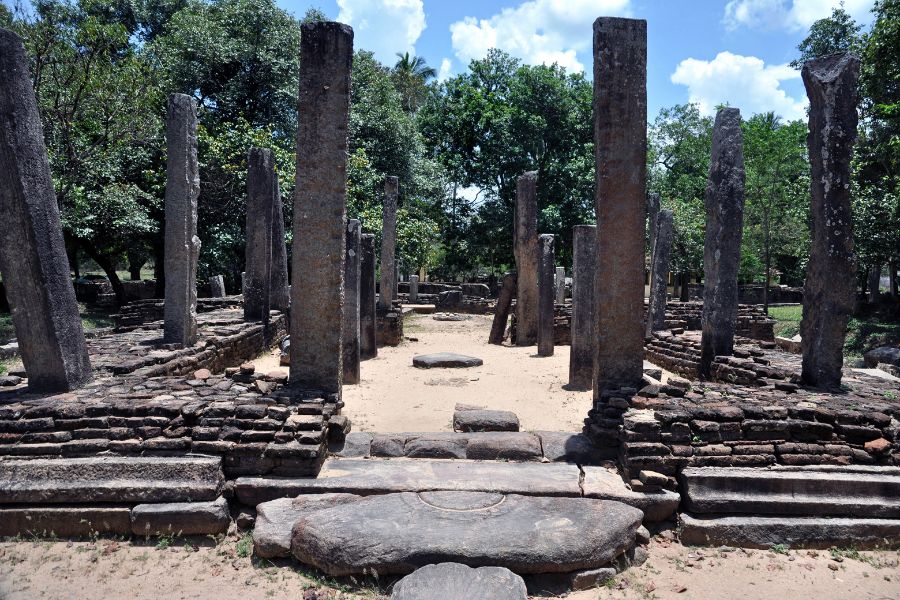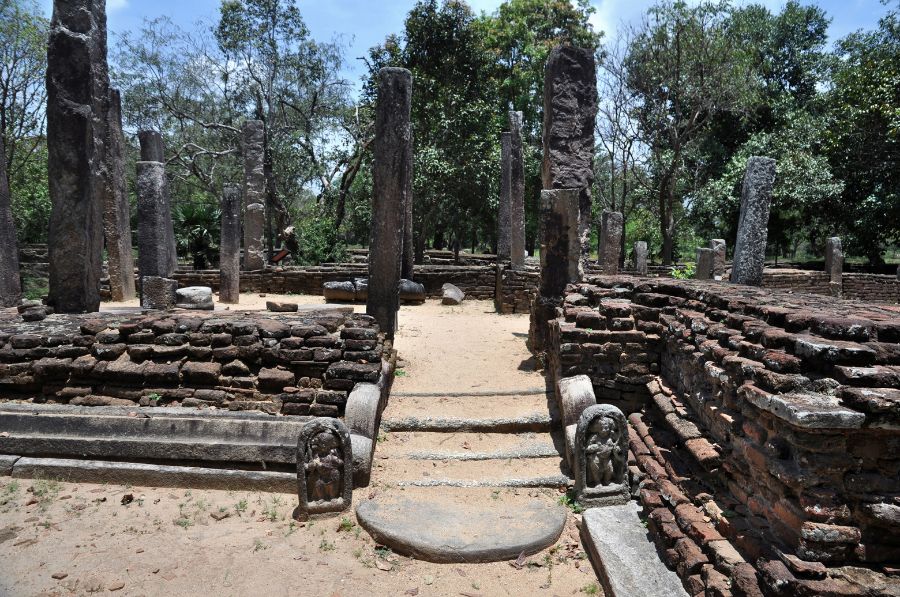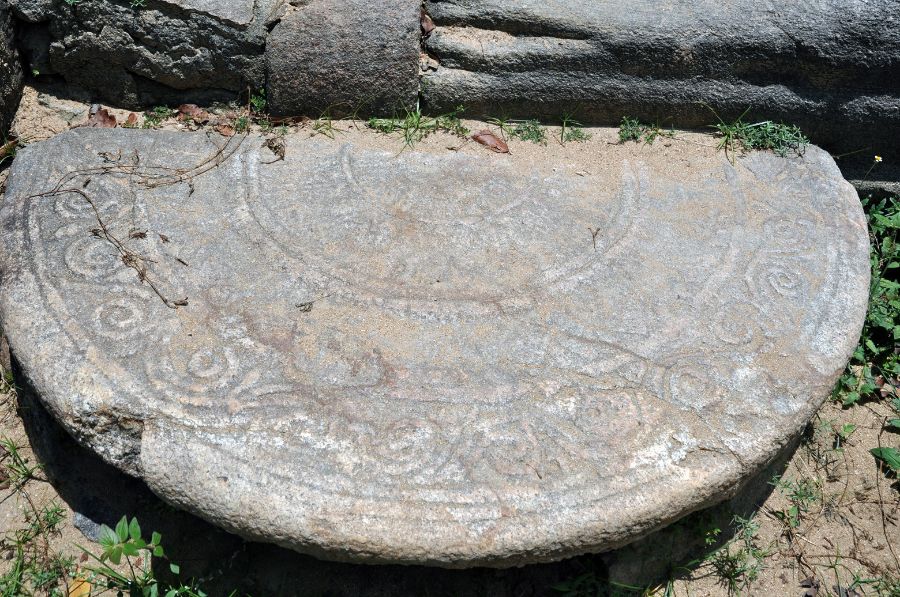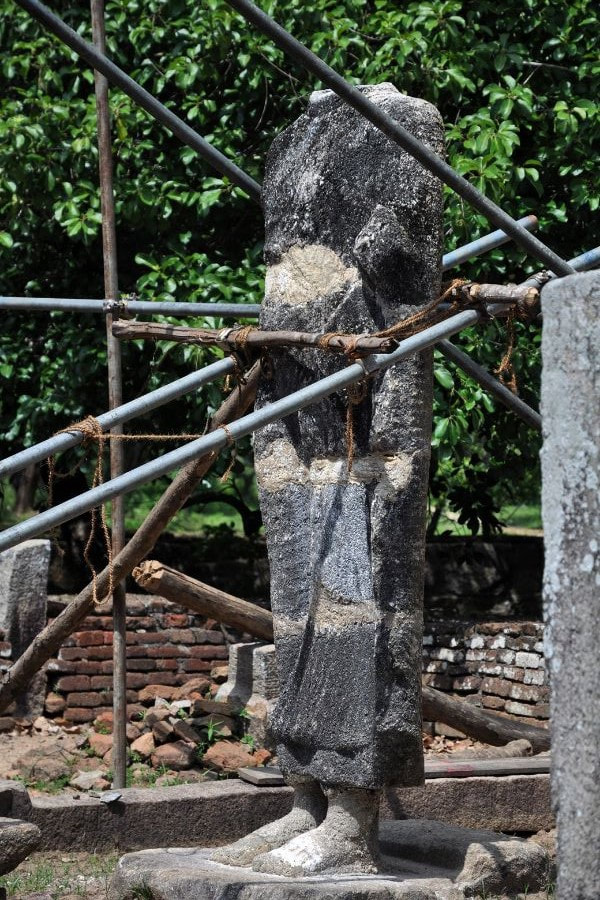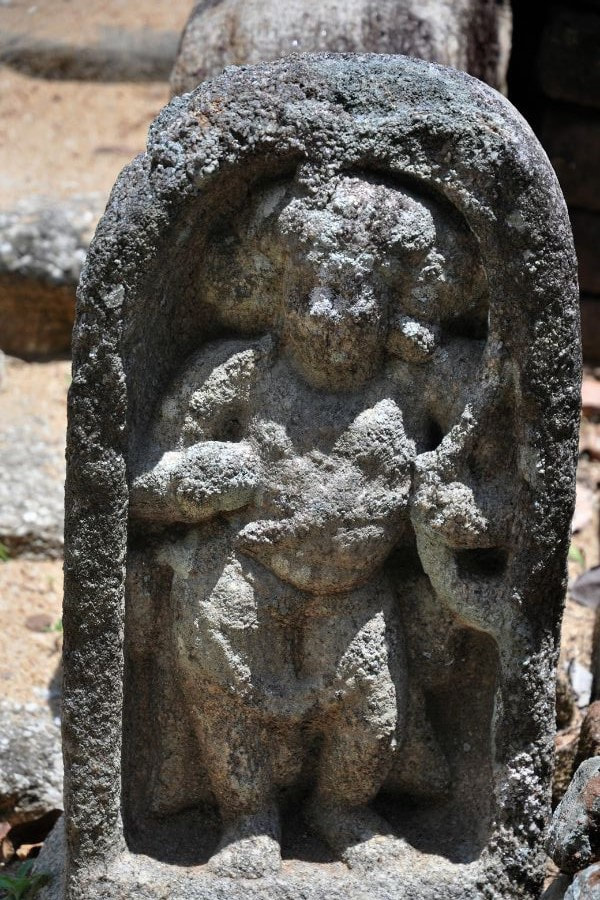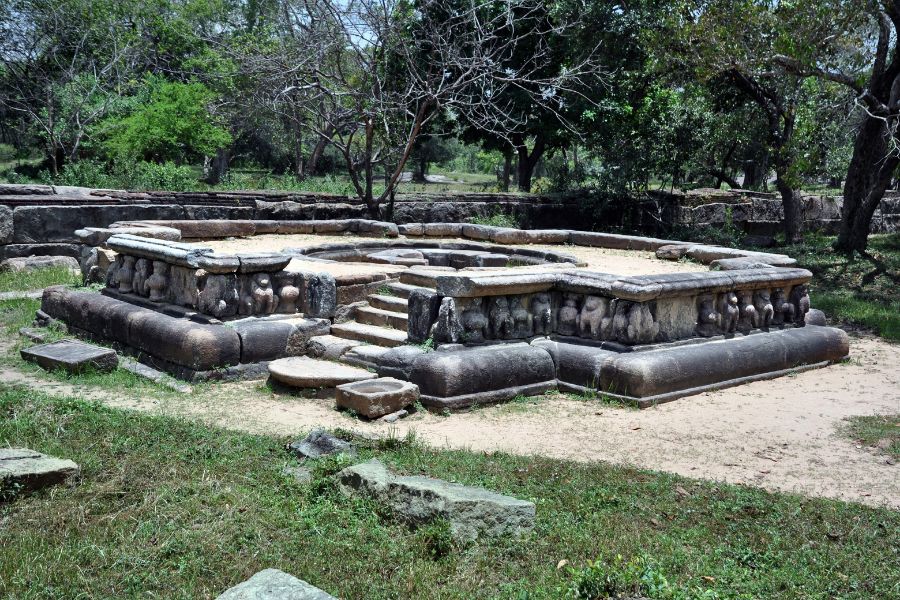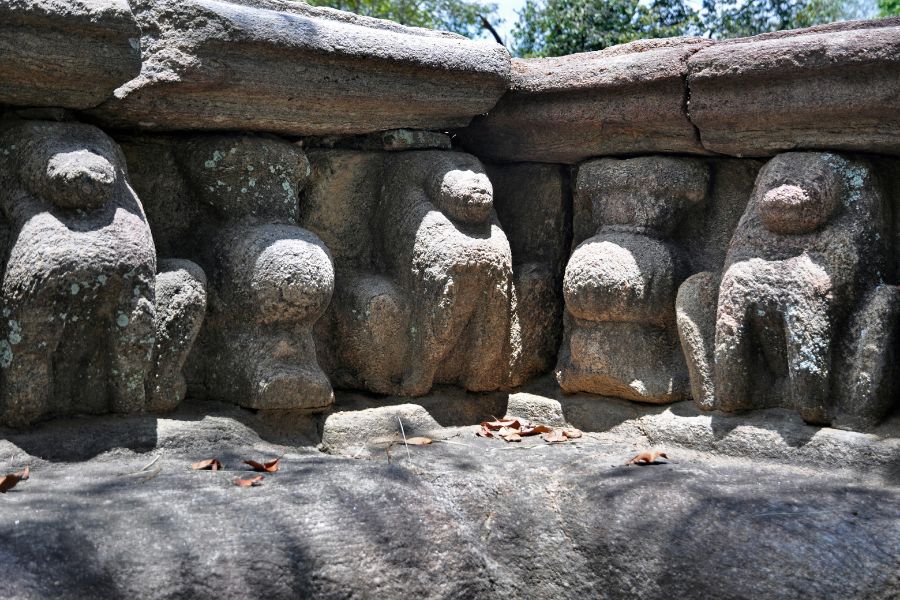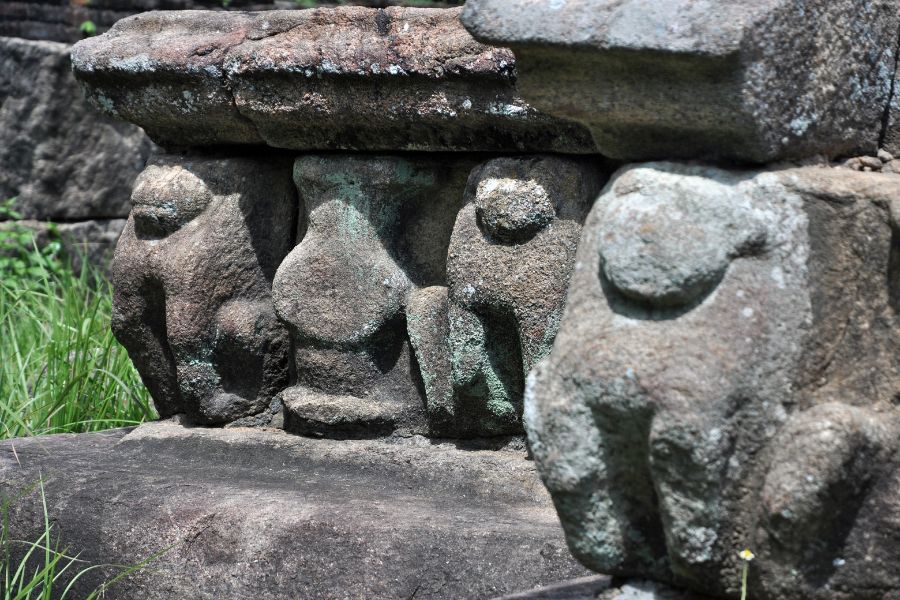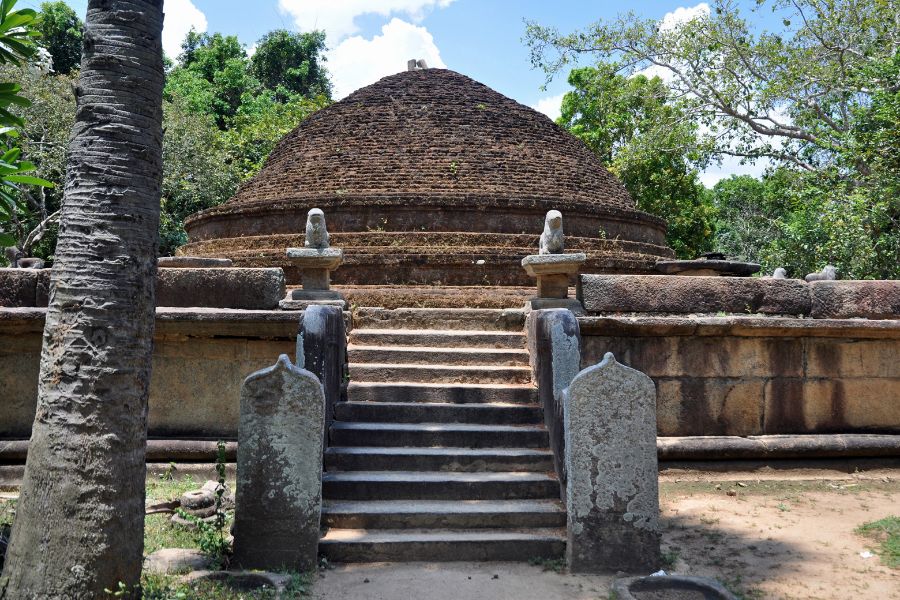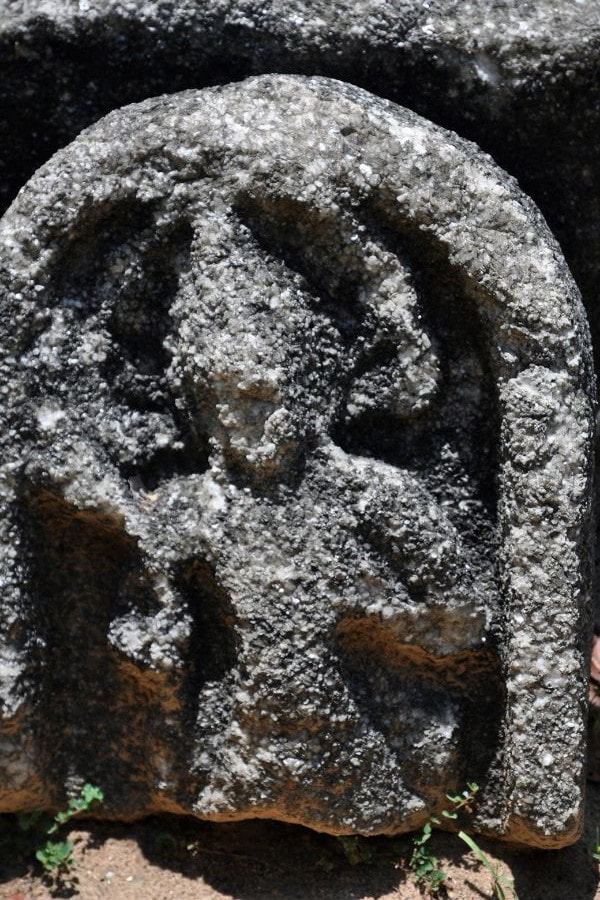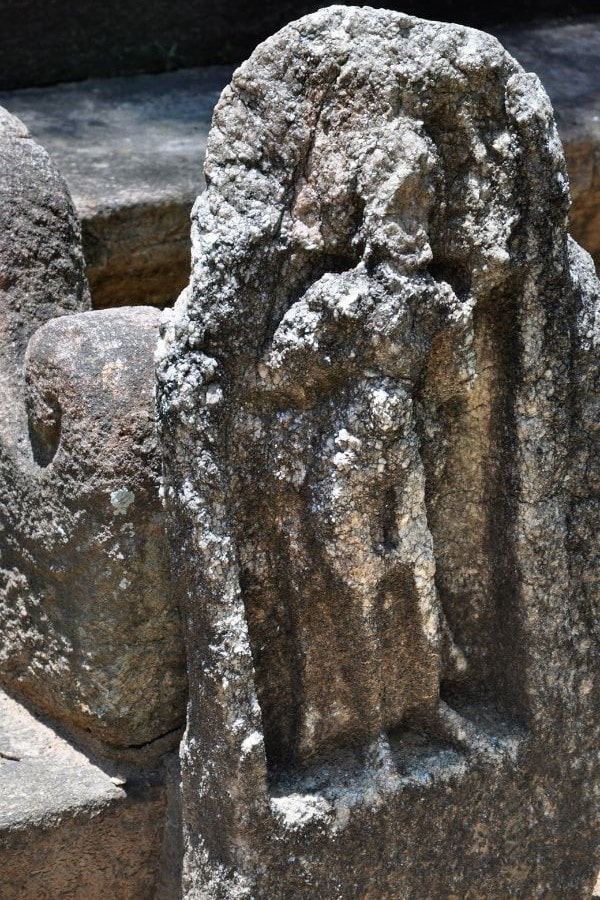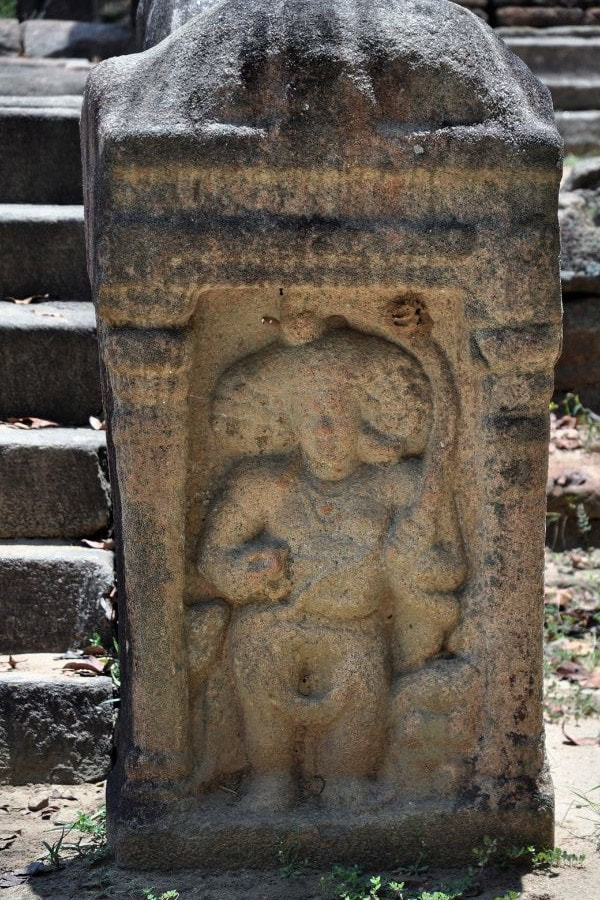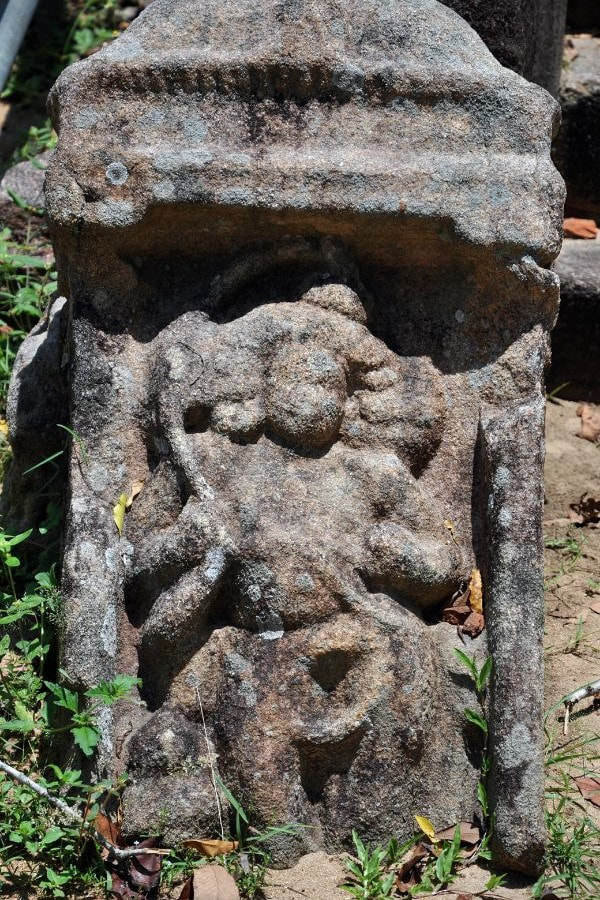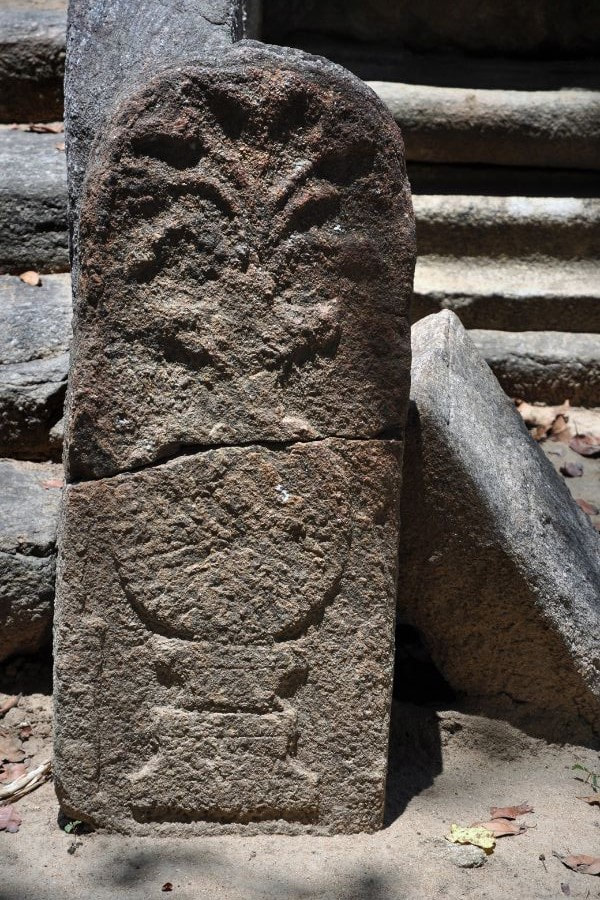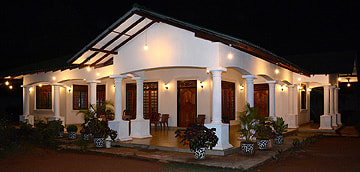Lahugala in the hinterland of Pottuvil and Arugam Bay is a village at the southern border of the Lahugala Kitulana National Park, which is one of Sri Lanka’s the smallest wildlife parks, a part of the man elephant corridor of southeastern Sri Lanka. Lahugala is one of the most important archaeological sites in southeastern Sri Lanka, too. According to local legends, the Magul Maha Viharaya, which translates to “Wedding Great Monastery”, was the place of the marriage of Princess Viharamahadevi, the most famous royal consort of Sri Lankan history. The systematically planned ancient monastery is similar in style to monasteries in the Cultural Triangle from the same period. But there are some interesting particularities to be discovered. For instance, the only highly elaborated moonstone of southern Sri Lanka differs in style from the contemporary Anuradhapura moonstones. The the ruins that can be seen today are in fact from the time of Viharamahdevi but almost one millennium younger, from the late Anuradhapura period.
Location
|
Lahugala, just 15 km (9 miles) inland from the east coast beach of Pottuvil via the A4 main riad, is a double attraction, both an archaeological site and a national park.
|
The ruins of the Magul Maha Vihara Monastery are located one kilometer south of the A4 raod. The aramic complex has been excavated since 1973.
The excavated Magul Maha Vihara monastery seems to be of modest dimensions when compared to the monastic complexes of Anradahpura, but one can study in Lahugala how far away from the Sinhalese center of civilization the same basic elements of an ancient Buddhist sanctuary occur and to what extent there are regional variations concerning details. Apart from Situlpahuwa in Yala National Park, there is no larger historical monastic complex in the southeast of the island than Lahugala. The region was the heartland of the former southern kingdom of Rohana during the Anuradhapura period.
The excavated Magul Maha Vihara monastery seems to be of modest dimensions when compared to the monastic complexes of Anradahpura, but one can study in Lahugala how far away from the Sinhalese center of civilization the same basic elements of an ancient Buddhist sanctuary occur and to what extent there are regional variations concerning details. Apart from Situlpahuwa in Yala National Park, there is no larger historical monastic complex in the southeast of the island than Lahugala. The region was the heartland of the former southern kingdom of Rohana during the Anuradhapura period.
LahugALA - Wedding Place of Dutugemunu's parents
The archaeological site of Lahugala is associated by locals with the story of the family of the Sinhalese national hero Dutugemunu (Dutthagamani), more precisely with the legendary first meeting of his parents. The story, handed down in the Mahavansa, is very well-known in Sri Lanka:
Against the raging ocean, the king of Kelaniya on the west coast had his daughter placed on a boat to offer her as a placating sacrifice. The boat, drifting along the shores of the island, ran aground in the southern kingdom of Rohana (Ruhunu in Sinhala), at a temple after which the princess found there was henceforth called the “monastery-grand-goddess”, Vihara-maha-devi. The king of Rohana, Kavantissa, soon took the stranded woman as his wife. Local tradition has it that this happened in the Lahugala area. Local traditions hold that Viharamahadevi was stranded on the nearby beaches of Pottuvil or Arugam Bay, or on both because her boat drifted away again after the first landing. (However, on the south coast Kirinda is thought to be that landing site, Dondra is also a candidate, but as said, all of this can be explained by the fact that the princess's boat drifted out to sea again, only to become stranded again.)
Against the raging ocean, the king of Kelaniya on the west coast had his daughter placed on a boat to offer her as a placating sacrifice. The boat, drifting along the shores of the island, ran aground in the southern kingdom of Rohana (Ruhunu in Sinhala), at a temple after which the princess found there was henceforth called the “monastery-grand-goddess”, Vihara-maha-devi. The king of Rohana, Kavantissa, soon took the stranded woman as his wife. Local tradition has it that this happened in the Lahugala area. Local traditions hold that Viharamahadevi was stranded on the nearby beaches of Pottuvil or Arugam Bay, or on both because her boat drifted away again after the first landing. (However, on the south coast Kirinda is thought to be that landing site, Dondra is also a candidate, but as said, all of this can be explained by the fact that the princess's boat drifted out to sea again, only to become stranded again.)
People on the east coast are certain that the royal wedding was held on the Magul Maruwa in Lahugala. "Magul Maruwa" means nothing other than “marriage platform”. The terrace is also called Magul Poruwa. "Maruwa" generally means "terrace", whereas "Poruwa" is a niche that is also raised and that us framed with curtains. Poruwas are still used today as a kind of throne for the wedding couple during traditional Sinhalese weddings ceremonies befitting their status.
After the wedding, the area was piously dedicated to the Sangha. It has become the home of a large number of Arahants, i.e. those people who, after the Buddha, also achieved enlightenment on the paths laid out by him and entered Nirvana. This ultimate goal, by the way, is is no longer attainablese today (and has not been for many centuries), according to orthodox Theravada view. Nirvana will only become attainable again in the future, with the arrival of the coming Buddha Maitreya.
Lahugala Archaeological Site
The attribution to Dutthagamani's parents is probably based on a pure similarity in name. A queen named Viharamahadevi from the 14th century is mentioned in the inscription as the sponsor of restoration works at the monastery. This late mediebal Viahramahadevi was the wife of two successive kings, namely Bhuwenaikabahus IV of Gampola and Parakramabahus V of Dedigama. Language and script of the inscription can be dated to the 14th century. One of the two pillar inscriptions in Lahugala mentions "Rohana Maha Vihara" as the historically correct name of the monastery, which suggests the great importance of the place in the Anuradhapura period, as it sounds like the southern counterpart to the main Mahavihara monastery in Anuradhapura. And as the original founder this inscription names no less than Dhatusena, the founder of the Moriya dynasty and builder of Kalawewas, who was murdered by his son Kassapa, as we know from the famous story of Sigiriya. Dhatusena indeed was a ruler of Rohana before coming to power in Anuradhapura.
Over a hundred pillars from temples from the Anuradhapura period were gradually excavated from the site now known as Lahugala Magul Maha Viharaya. Many of them got lost during the civil war as a result of art theft or smuggling. Officials and monks blamed each other for being responsible, involved in the theft or not protecting the heritage site sufficiently.
Nevertheless, a number of structures and objects worth seeing have been preserved on site. The buildings, which were cleared of the jungle for the first time in the 14th century, do not date from the time of Dhatusena (453-74), they are several centuries younger, namely from the late Anuradhapura period. This is evidenced by the type of building decoration, in particular by the large number of carved moonstones in relief.
Nevertheless, a number of structures and objects worth seeing have been preserved on site. The buildings, which were cleared of the jungle for the first time in the 14th century, do not date from the time of Dhatusena (453-74), they are several centuries younger, namely from the late Anuradhapura period. This is evidenced by the type of building decoration, in particular by the large number of carved moonstones in relief.
The chapter house to the left of the entrance has an unusually large and beautifully reliefed moonstone, one of the most worth seeing examples of this classic Sri Lankan art form at all. What is unique about this moonstone is that in the band with depictions of elephants, in addition to the animals, their drivers, the mahouts, are also shown. Of the twelve carved elepants, four carry small drivers. The elephants themselves are depicted quite individually. Every second individual places his trunk on the back of the elephant in front of him.
The design of the large moonstone from Lahugala does not entirely correspond to the original Anuradhapura moonstones, as these depict cattle, lions and horses in the same outer band as well as elephants. But a similar restriction on the elephant is also known elsewhere in the southern kingdom, namely in the Ramba Vihara. The Lahugala moonstones are probably simplified versions of the larger models from the late Anuradhapura period.
The staircase behind this largest moonstone in Lahugala also suggests that the entrance and the building date to the Anuradhapura period. On each step front you can see three Gana gnomes, each framed by two Purnagatha vases, just like at the Mahasena Palace in Anuradhapura, whereas the staircases of Polonnaruwa entrances have a continuous band of more numerous Ganas on each step.
The design of the large moonstone from Lahugala does not entirely correspond to the original Anuradhapura moonstones, as these depict cattle, lions and horses in the same outer band as well as elephants. But a similar restriction on the elephant is also known elsewhere in the southern kingdom, namely in the Ramba Vihara. The Lahugala moonstones are probably simplified versions of the larger models from the late Anuradhapura period.
The staircase behind this largest moonstone in Lahugala also suggests that the entrance and the building date to the Anuradhapura period. On each step front you can see three Gana gnomes, each framed by two Purnagatha vases, just like at the Mahasena Palace in Anuradhapura, whereas the staircases of Polonnaruwa entrances have a continuous band of more numerous Ganas on each step.
Moonstones of this size and richness of detail probably only came on the scene in the last three or four centuries of Anuradhapura art. However, this dating cannot be taken for granted, since Indian models are much older. The moonstones from Lahugala may even be products of the Polonnaruwa period. However, it's more likely they are from the Anuradhapura period. Firstly, Polonnaruwa moonstones are otherwise not known from places outside Polonnaruwa. Secondly, the decorated concentric bands of the Lahugala moonstone are separated by thin semicircular bands, almost like lines, just as in the case of the classical Anuradhapura moonstone, whereas these separating elements are wider and in themselves more decorated on Polonnaruwa moonstones. Thirdly, the band showing the geese (hamsas) is closer to the center in Lahugala than the band of mammals, in the case of Polonnaruwa moonstones the geese are usually carved on the outermost semicircular band.
The dating of the Lahugala Magul Maha Vihara to the 7th to 10th century is also supported by the planned overall complex, which is very reminiscent of the systematically arranged floor plans of the Pabbata Viharas of the late Anuradhapura period:
The entire aramic complex consists of three staggered areas. As with the Pabbata viharas, the outermost area was used for supplies, ramparts or ditches also surrounded most of Anuradhapura's pabbata viharas. Similarly, there are seven lotus ponds in Lahugala, which today frame the temple. Between the outer boundary and the ceremonial center was the monks' living quarter, just like in the Pabbata Viharas. The monks' cells called Kutis stood in that area, sparse remains of such cells can still be seen in the outer area of Lahugala.
The dating of the Lahugala Magul Maha Vihara to the 7th to 10th century is also supported by the planned overall complex, which is very reminiscent of the systematically arranged floor plans of the Pabbata Viharas of the late Anuradhapura period:
The entire aramic complex consists of three staggered areas. As with the Pabbata viharas, the outermost area was used for supplies, ramparts or ditches also surrounded most of Anuradhapura's pabbata viharas. Similarly, there are seven lotus ponds in Lahugala, which today frame the temple. Between the outer boundary and the ceremonial center was the monks' living quarter, just like in the Pabbata Viharas. The monks' cells called Kutis stood in that area, sparse remains of such cells can still be seen in the outer area of Lahugala.
A surrounding wall also clearly demarcates the ceremonial center of the monastery as the inner courtyard. (The walling of the Magul Maha Vihara in Lahugala, however, is interpreted by locals as a fortification where weapons, animals and food were kept in preparation for Dutthagamani's war against Elara in Anuradhapura.)
The most striking parallel between the Lahugala Magul Maha Viharaya and Pabbata Viharayas from the late Anuradhapura period is that the same kinds of four ceremonial buildings are grouped in the specially walled inner courtyard, namely an assembly hall, a stupa, an image house, and a tree sanctuary. Although this courtyard is not clearly elevated - the archaeological term Pabbata Vihara literally means "mountain monastery" after the raised central platform on which those four buildings stand together - some the Pabbata Viharas in the Anuradhapura area do not have a clearly elevated ground level in the center, either.
The most striking parallel between the Lahugala Magul Maha Viharaya and Pabbata Viharayas from the late Anuradhapura period is that the same kinds of four ceremonial buildings are grouped in the specially walled inner courtyard, namely an assembly hall, a stupa, an image house, and a tree sanctuary. Although this courtyard is not clearly elevated - the archaeological term Pabbata Vihara literally means "mountain monastery" after the raised central platform on which those four buildings stand together - some the Pabbata Viharas in the Anuradhapura area do not have a clearly elevated ground level in the center, either.
The structure with the most columns in the former monastery center is an image house, a Pathimagara. Like the comparable image houses known from the area around Anuradhapura, the building has two doors, one entrance in the main axis and an additional side exit from the vestibule. In front of the latter is another moonstone. However, this one is smaller and less elaborate.
A few stone doorposts have been preserved from the image house, only the lower parts of the carving remains, depicting a Buddha sculpture's robe. To the left of the front entrance is the stele with the Lahugala inscription. Also noteworthy are the squat guard steles on the side of the main entrance, they sow a very unusual hairstyle.
The “wedding platform,” the said Magul Poruwa, for King Kavantissa and his rescued bride, was actually a platform for a bo tree. It’s notable for the all-round lion frieze at the base of the terrace. Stupa terraces are more likely to be “supported” by elephant friezes, but the Bodhighara at Nillakgama also has lion frieze at the base of the bo tree pedestal. Next to the Bo-Tree terrace, there is a rock inscription, now protected by a fence.
The stupa, which today reaches a height of 9 m (30 feet), is also small but beautiful. This dagoba is made of bricks and was found heavily overgrown. The substructure, however, has a surround made of very large and carefully hewn natural stones.
The stupa, which today reaches a height of 9 m (30 feet), is also small but beautiful. This dagoba is made of bricks and was found heavily overgrown. The substructure, however, has a surround made of very large and carefully hewn natural stones.
Staircases on three sides lead to the stupa platform. Each staircase is flanked by makara balustrades and guardian stones, as is common in classic Sinhalese temple buildings, but here you can see two additional small, yet impressive sculptural lion statues atop, next to the stairs.
The gatehouses in all four directions are also interesting in Lahugala. Inside, besides the stone pillars, you can also see post holes for additional wooden pillars.
On the sides of the passages of the eastern gateway, for example, there are small guard steles that differ significantly from each other, both in the choice of motifs and in the relief technique.
The gatehouses in all four directions are also interesting in Lahugala. Inside, besides the stone pillars, you can also see post holes for additional wooden pillars.
On the sides of the passages of the eastern gateway, for example, there are small guard steles that differ significantly from each other, both in the choice of motifs and in the relief technique.
|
In addition to guardstones, you can also see so-called Purnagathas, the vessels of abundance, depicted on the inside of the south gate. Thanks to the moonstones and guardian steles, Lahugala is much richer in relief art than the larger excavation in the south, the Rambavihara at Embilipitiya.
In the refuge in front of the main gate in the north there are two other small attractions worth seeing, namely real elephant skulls. |
Nilagiri
Six kilometers southwest of Lahugala is the Nilagiri Rock, strictly speaking there are two groups of rocks, called Nilagiriseya and, a little further south, Nilagirihena, each with an old stupa and very old hermit caves. Inscriptions on the caves southeast of Nilagiri date back to pre-Christian centuries. The Nilagiri Dagoba is believed to be a work of the first century AD king Madathika Mahanaga, mentioned in the chronicles as Pasanadipaka Vihara. Buddha statues were not found at these ancient sites, which are much older than the buildings at Lahugala, probably because the sites had already been abandoned before the Buddha images appeared.
North of Lahugala lies the relatively flat “elephant rock” Ätgala, also with a dagoba, which is called Kotavehera. All these places are not entirely safe for visitors because of the wild elephants.
North of Lahugala lies the relatively flat “elephant rock” Ätgala, also with a dagoba, which is called Kotavehera. All these places are not entirely safe for visitors because of the wild elephants.
Lahugala-Kitulana National Park
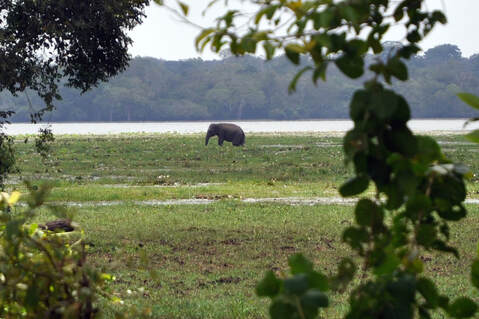
A wildlife sanctuary was first established around Lahugala in 1966, and in 1980 it became a national park, one of the smallest in Sri Lanka, but important for the elephant population and endemic bird species of the dry region.
The landscape is characterized by the typical bushland of the dry zone, but towards the rivers of Heda Oya in the south and Koranda Oya in the north, there is even dense forest with tall trees. From vantage points you can see the hills of Uva in the distance and, closer by, the rocky hill that the British called Westminster Abbey.
The Mahawewa, the largest reservoir of the region, has a 1200m long historic dam and covers an area of almost 250 hectares. In the Anuradhapura period it was fed by a 10 km long canal that diverted water from the Heda Oya. At kilometer marker 191 there is an observation point from which you can see the tanks. A circuit bungalow is directly at the lake. However, you are not allowed to leave it to go to the bank because that would disturb the elephants and would be too dangerous.
Though Lahugala Kitulana National Park is much smaller than its neighbouring national parks, Gal Oya in the north and Yala in the south, there there is a not so small herd of elephants of at least 50 individuals living in the area. Because of the three tanks in this area, Mahawewa, Kitulana and Sengamuwa, this number increases to up to 150 elephants during the local dry season from August to October, because many animals migrate to the said lakes from the then parched area of Yala National Park. The pachyderms regularly gather for their kind of 5 o'clock tea preferably at the largest of the three lakes, the Mahawewa. The latter is also simply called Lahugala Tank after the nearby village. The wild animals can be seen roaming along the road in small groups during the daylight hours or sporadically they can be spotted in the nearby bushland. Elephants love the tall beru grass (Oplismenus compostus, also called Sacciolepis interrupta), which covers the lakes extensively and is found nowhere in Sri Lanka in such öarge quantities as here. Swamp crocodiles live at the tanks and swamps of Laugala Kitulana, too.
In the morning hours you can observe herds of axis deer and wild boars at the lakes. Bears and the three local big cats, namely leopards, fishing cats and rusty cats, are rarely seen. The latter only live in southern India and Sri Lanka; they are close relatives of the Bengal cat. Other mammal species in the park include sambar deer and the smaller Indian muntjac deer, golden jackals, Indian armadillos, black-naped hares, sloth bears native only to India and Sri Lanka, and the two monkey species most common in Sri Lanka, Toque macaques and Purple-faced langurs, both endemic to the island.
Lahugala is known for its abundance of birds. Because of the lakes, water birds can also be seen in addition to the typical bird life of the dry region, and because of the forests in the direction of Heda Oya, the rare and endemic Red-faced Malkoha (Phaenicophaeus pyrrhocephalus) also occurs. In keeping with the name, this bird has a strikingly red face, while the plumage is otherwise black and white only at the abdomen. A special feature of Lahugala is the abundance of birds of prey. Because of the proximity to the coast, the medium-sized Brahminy kites (Haliastur indus) are pretty common. These resident birds feed on both small carrion and living aquatic animals, as well as fish, crustaceans, reptiles and amphibians. Smaller in size are the hawk-like shikras (Accipeter badius), which are widespread throughout Africa and Asia. The Ceylonese grey-headed fish eagle (Ichthyophaga ichthyaetus) with very dark plumage often lurks on tree stumps. In Sri Lanka this bird of prey is also called by the shorter English names “tank eagle” or simply “fish eagle”. The white-bellied sea eagle (Haliaeetus leucogaster), which is quite impressive in flight, is widespread throughout tropical Asia and Australia. You can easily recognize these large birds by its white body and wings and their black rear and outer edges. With a wingspan of up to 2.2 m (7.2 ft), and a weight of 4.5 kg (9.9 lb), sea eagles grow are even bigger than fish eagles.
The surrounding villagers had left the Lahugala area for many years during the civil war. Although the rebel army of the separatist LTTE and large army units did not clash so far from the north, armed gangs from various Tamil organizations fought from time to time and, above all, extorted support from the local farmers. After the violent end of the civil war, local residents were returning, and the national park - like most of those that were closed due to the civil war - has been accessible again since January 2010.
The landscape is characterized by the typical bushland of the dry zone, but towards the rivers of Heda Oya in the south and Koranda Oya in the north, there is even dense forest with tall trees. From vantage points you can see the hills of Uva in the distance and, closer by, the rocky hill that the British called Westminster Abbey.
The Mahawewa, the largest reservoir of the region, has a 1200m long historic dam and covers an area of almost 250 hectares. In the Anuradhapura period it was fed by a 10 km long canal that diverted water from the Heda Oya. At kilometer marker 191 there is an observation point from which you can see the tanks. A circuit bungalow is directly at the lake. However, you are not allowed to leave it to go to the bank because that would disturb the elephants and would be too dangerous.
Though Lahugala Kitulana National Park is much smaller than its neighbouring national parks, Gal Oya in the north and Yala in the south, there there is a not so small herd of elephants of at least 50 individuals living in the area. Because of the three tanks in this area, Mahawewa, Kitulana and Sengamuwa, this number increases to up to 150 elephants during the local dry season from August to October, because many animals migrate to the said lakes from the then parched area of Yala National Park. The pachyderms regularly gather for their kind of 5 o'clock tea preferably at the largest of the three lakes, the Mahawewa. The latter is also simply called Lahugala Tank after the nearby village. The wild animals can be seen roaming along the road in small groups during the daylight hours or sporadically they can be spotted in the nearby bushland. Elephants love the tall beru grass (Oplismenus compostus, also called Sacciolepis interrupta), which covers the lakes extensively and is found nowhere in Sri Lanka in such öarge quantities as here. Swamp crocodiles live at the tanks and swamps of Laugala Kitulana, too.
In the morning hours you can observe herds of axis deer and wild boars at the lakes. Bears and the three local big cats, namely leopards, fishing cats and rusty cats, are rarely seen. The latter only live in southern India and Sri Lanka; they are close relatives of the Bengal cat. Other mammal species in the park include sambar deer and the smaller Indian muntjac deer, golden jackals, Indian armadillos, black-naped hares, sloth bears native only to India and Sri Lanka, and the two monkey species most common in Sri Lanka, Toque macaques and Purple-faced langurs, both endemic to the island.
Lahugala is known for its abundance of birds. Because of the lakes, water birds can also be seen in addition to the typical bird life of the dry region, and because of the forests in the direction of Heda Oya, the rare and endemic Red-faced Malkoha (Phaenicophaeus pyrrhocephalus) also occurs. In keeping with the name, this bird has a strikingly red face, while the plumage is otherwise black and white only at the abdomen. A special feature of Lahugala is the abundance of birds of prey. Because of the proximity to the coast, the medium-sized Brahminy kites (Haliastur indus) are pretty common. These resident birds feed on both small carrion and living aquatic animals, as well as fish, crustaceans, reptiles and amphibians. Smaller in size are the hawk-like shikras (Accipeter badius), which are widespread throughout Africa and Asia. The Ceylonese grey-headed fish eagle (Ichthyophaga ichthyaetus) with very dark plumage often lurks on tree stumps. In Sri Lanka this bird of prey is also called by the shorter English names “tank eagle” or simply “fish eagle”. The white-bellied sea eagle (Haliaeetus leucogaster), which is quite impressive in flight, is widespread throughout tropical Asia and Australia. You can easily recognize these large birds by its white body and wings and their black rear and outer edges. With a wingspan of up to 2.2 m (7.2 ft), and a weight of 4.5 kg (9.9 lb), sea eagles grow are even bigger than fish eagles.
The surrounding villagers had left the Lahugala area for many years during the civil war. Although the rebel army of the separatist LTTE and large army units did not clash so far from the north, armed gangs from various Tamil organizations fought from time to time and, above all, extorted support from the local farmers. After the violent end of the civil war, local residents were returning, and the national park - like most of those that were closed due to the civil war - has been accessible again since January 2010.
